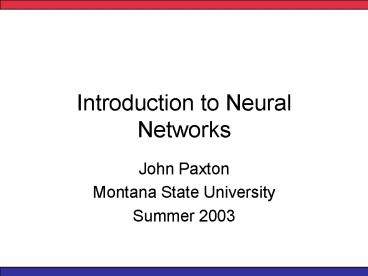Introduction to Neural Networks - PowerPoint PPT Presentation
Title:
Introduction to Neural Networks
Description:
Can handle weak (desirable, but not required) constraints. ... ui1 connected to ukn with -dik. U11. Un1. Unn. U1n. b -p. Algorithm. 1. Initialize weights b, p ... – PowerPoint PPT presentation
Number of Views:58
Avg rating:3.0/5.0
Title: Introduction to Neural Networks
1
Introduction to Neural Networks
- John Paxton
- Montana State University
- Summer 2003
2
Chapter 7 A Sampler Of Other Neural Nets
- Optimization Problems
- Common Extensions
- Adaptive Architectures
- Neocognitron
3
I. Optimization Problems
- Travelling Salesperson Problem.
- Map coloring.
- Job shop scheduling.
- RNA secondary structure.
4
Advantages of Neural Nets
- Can find near optimal solutions.
- Can handle weak (desirable, but not required)
constraints.
5
TSP Topology
- Each row has 1 unit that is on
- Each column has 1 unit that is on
1st 2nd 3rd
City A City B City C
6
Boltzmann Machine
- Hinton, Sejnowski (1983)
- Can be modelled using Markov chains
- Uses simulated annealing
- Each row is fully interconnected
- Each column is fully interconnected
7
Architecture
- ui,j connected to uk,j1 with di,k
- ui1 connected to ukn with -dik
b
-p
U11
U1n
Un1
Unn
8
Algorithm
- 1. Initialize weights b, p p gt b p gt
greatest distance between cities Initialize
temperature T - Initialize activations of units to random
binary values
9
Algorithm
- 2. while stopping condition is false, do steps
3 8 - 3. do steps 4 7 n2 times (1 epoch)
- 4. choose i and j randomly 1 lt i, j lt n
uij is candidate to change state
10
Algorithm
- 5. Compute c 1 2uijb S S ukm (-p)
- where k ltgt i, m ltgt j
- 6. Compute probability to accept change
- a 1 / (1 e(-c/T) )
- 7. Accept change if random number 0..1
- lt a. If change, uij 1 uij
- 8. Adjust temperature T .95T
11
Stopping Condition
- No state change for a specified number of epochs.
- Temperature reaches a certain value.
12
Example
- T(0) 20
- ½ units are on initially
- b 60
- p 70
- 10 cities, all distances less than 1
- 200 or fewer epochs to find stable configuration
in 100 random trials
13
Other Optimization Architectures
- Continuous Hopfield Net
- Gaussian Machine
- Cauchy Machine
- Adds noise to input in attempt to escape from
local minima - Faster annealing schedule can be used as a
consequence
14
II. Extensions
- Modified Hebbian Learning
- Find parameters for optimal surface fit of
training patterns
15
Boltzmann Machine With Learning
- Add hidden units
- 2-1-2 net below could be used for simple
encoding/decoding (data compression)
y1
x1
z1
x2
y2
16
Simple Recurrent Net
- Learn sequential or time varying patterns
- Doesnt necessarily have steady state output
- input units
- context units
- hidden units
- output units
17
Architecture
c1
x1
z1
y1
xn
zp
ym
cp
18
Simple Recurrent Net
- f(ci(t)) f(zi(t-1))
- f(ci(0)) 0.5
- Can use backpropagation
- Can learn string of characters
19
Example Finite State Automaton
- 4 xi
- 4 yi
- 2 zi
- 2 ci
A
BEGIN
END
B
20
Backpropagation In Time
- Rumelhart, Williams, Hinton (1986)
- Application Simple shift register
1 (fixed)
x1
y1
x1
z1
x2
y2
x2
1 (fixed)
21
Backpropagation Training for Fully Recurrent Nets
- Adapts backpropagation to arbitrary connection
patterns.
22
III. Adaptive Architectures
- Probabilistic Neural Net (Specht 1988)
- Cascade Correlation (Fahlman, Lebiere 1990)
23
Probabilistic Neural Net
- Builds its own architecture as training
progresses - Chooses class A over class B if hAcAfA(x) gt
hBcBfB(x) - cA is the cost of classifying an example as
belonging to A when it belongs to B - hA is the a priori probability of an example
belonging to class A
24
Probabilistic Neural Net
- fA(x) is the probability density function for
class A, fA(x) is learned by the net - zA1 pattern unit, fA summation unit
zA1
fA
x1
zAj
y
zB1
fB
xn
zBk
25
Cascade Correlation
- Builds own architecture while training progresses
- Tries to overcome slow rate of convergence by
other neural nets - Dynamically adds hidden units (as few as
possible) - Trains one layer at a time
26
Cascade Correlation
- Stage 1
x0
y1
x1
y2
x2
27
Cascade Correlation
- Stage 2 (fix weights into z1)
x0
y1
x1
z1
y2
x2
28
Cascade Correlation
- Stage 3 (fix weights into z2)
x0
y1
z1
z2
x1
y2
x2
29
Algorithm
- 1. Train stage 1. If error is not acceptable,
proceed. - 2. Train stage 2. If error is not
- acceptable, proceed.
- 3. Etc.
30
IV. Neocognitron
- Fukushima, Miyako, Ito (1983)
- Many layers, hierarchical
- Very spare and localized connections
- Self organizing
- Supervised learning, layer by layer
- Recognizes handwritten 0, 1, 2, 3, 9,
regardless of position and style
31
Architecture
Layer of Arrays Size
Input 1 192
S1 / C1 12 / 8 192 / 112
S2 / C2 38 / 22 112 / 72
S3 / C3 32 / 30 72 / 72
S4 / C4 16 / 10 32 / 12
32
Architecture
- S layers respond to patterns
- C layers combine results, use larger field of
view - For example S11 responds to 0 0 0 1 1 1 0 0 0
33
Training
- Progresses layer by layer
- S1 connections to C1 are fixed
- C1 connections to S2 are adaptable
- A V2 layer is introduced between C1 and S2, V2 is
inhibatory - C1 to V2 connections are fixed
- V2 to S2 connections are adaptable















![Introduction to Artificial Neuron Networks [ANN] PowerPoint PPT Presentation](https://s3.amazonaws.com/images.powershow.com/6292342.th0.jpg?_=20150319091)















